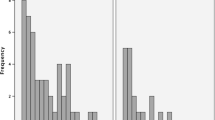Summary
The autopsy reports of 233 babies and children aged between 5 days and 7 years, including 190 cases of non-traumatic and 43 cases of traumatic death, were reviewed. In 94 out of 190 cases of death due to natural causes, attempted resuscitation (closed-chest massage) was performed and only in 2 cases could fractures of the ribs localized on both sides in the midclavicular line be observed. In 15 of the 43 cases of death due to traumatic events, fractures mainly of the posterior ends of the ribs occurred. These observations support the published findings of other authors which indicate that fractures of ventral parts of the thorax can occur during resuscitation. Fractures localized in particular in dorsal parts of the chest wall of infants without metabolic bone diseases, however, must be interpreted as a strong indication of physical child abuse. It was observed that relevant injuries due to resuscitation are caused much more frequently or almost exclusively by physicians than by non-medical persons. This finding refutes any possible claims that rib fractures were caused by inexpert resuscitation in a panic-like reaction.
Zusammenfassung
Es wurden die Sektionsprotokolle von 233 Säuglingen und Kindern in einem Alter zwischen 5 Tagen und 7 Jahren ausgewertet (190 Fälle mit nichttraumatischer und 43 Fälle mit traumatischer Todesursache). In 94 der 190 nicht-traumatischen Todesfälle waren Reanimationsmaßnahmen einschließlich Herzdruckmassage durchgeführt worden. Lediglich zweimal war es zu Frakturen der Rippen beidseits in der mittleren Klavikularlinie gekommen, hingegen ließen sich in 15 der 43 Fälle mit traumatischer Todesursache Brüche hauptsächlich der paravertebralen Anteile der Rippen feststellen. Die Ergebnisse bestätigen, daß Rippenbrüche bei Säuglingen bzw. Kindern im Rahmen von Wiederbelebungsmaßnahmen ein sehr seltenes Ereignis darstellen und v. a. dorsal lokalisierte Brüche müssen — bei Fehlen von Skeletterkrankungen —als nahezu eindeutige Hinweise auf körperliche Mißhandlung angesehen werden. Die Beobachtung, daß schwerwiegende Reanimationsverletzungen weit überwiegend bzw. nahezu ausschließlich im Rahmen ärztlicher Wiederbelebungsversuche auftreten und nicht von medizinischen Laien gesetzt werden, kann ferner als Argument gegen die mögliche Einlassung, die Verletzungen seien aufgrund von Panik und “Schock” durch die betreuende Person induziert worden, gewertet werden.
Similar content being viewed by others
References
Caffey J (1974) The whiplash shaken infant syndrome. Pediatrics 54: 396–403
Cameron JM, Rae L (1975) The radiological diagnosis. Differential diagnosis. In: Atlas of the Battered Child Syndrome. London, Churchill Livingstone, pp 20–64
Duhaime AC, Gennarelli TA, Thibault LE, Bruce DA, Margulies SS, Wiser R (1987) The shaken baby syndrome. A clinical, pathological and biochemical study. J Neurosurg 66: 409–415
Feldman KW, Brewer DK (1984) Child abuse, cardiopulmonary resuscitation, and rib fractures. Pediatrics 73: 339–342
Gregg GS, Elmer E (1969) Infant injuries: accident or abuse? Pediatrics 44: 434–439
Guthkelch AN 1971 Infantile subdural haematoma and its relationship to whiplash injuries. BMJ: 430–431
Kempe CH, Helfer RE (eds) (1980) The battered child. The University of Chicago Press, Chicago, London
Kleinman PK (1987) Diagnostic imaging of child abuse. Williams & Wilkins, Baltimore London Los Angeles Sydney, pp 67–89
Knight B (1992) The pathology of child abuse. Malays J Pathol 14: 63–67
Larkin S (1992) Child abuse on the rise. Mo Dent 172: 18–21
Möller JC (1990) Infant skull fractures and child abuse. Z Rechtsmed 103: 311–313
Newberger EH (1993) Child physical abuse. Prim Care 20: 317–327
Rossier A, Paupe J, Michelin J, Larnaudie J (1958) Dystrophie osseuse ostéomalacique chez des extrêmes prématurés. Arch Fr Pédiatr 15: 477–498
Saternus KS (1981) Direct and indirect trauma in resuscitation. Z Rechtsmed 86: 161–174
Saternus KS, Oehmichen M (1985) Kardiopulmonale Reanimation bei Säuglingen. Der Notarzt 1: 77–81
Smith FW, Gilday DL, Ash JM, Green MD (1980) Unsuspected costo-vertebral fractures demonstrated by bone scanning in the child abuse syndrome. Pediatr Radiol 10: 103–106
Thomas PS (1977) Rib fractures in infancy. Ann Radiol (Paris) 20: 115–122
Tracy T Jr, O'Connor TP, Weber TR (1993) Battered children with duodenal avulsion and transection. Am Surg 59: 342–345
Author information
Authors and Affiliations
Rights and permissions
About this article
Cite this article
Betz, P., Liebhardt, E. Rib fractures in children — resuscitation or child abuse?. Int J Leg Med 106, 215–218 (1994). https://doi.org/10.1007/BF01371340
Received:
Revised:
Issue Date:
DOI: https://doi.org/10.1007/BF01371340




